Citizens’ Perception of Smart Cities: A Case Study
Abstract
1. Introduction
2. Literature Review
3. Smart City
3.1. Sustainable Urban Development
3.2. Smart City Dimensions
4. Survey Methodology and Analysis
4.1. Research Questions
- 1.
- How many of the citizens who participated in the survey have heard about the “smart city” term? How is the result formed when age, gender and city factors are taken into account?
- 2.
- How many of the participants have a decent (or probably better) knowledge of what a smart city is? How is the result formed when age, gender and city factors are taken into account?
- 3.
- How many of the participants believe that actions have been made in their city so that it can be transformed into a smart city in a holistic way? How is the result formed when the city factor is taken into account?
- 4.
- According to the participants, Which challenges are considered as the most important for the development of a smart city? How do these results form when the city factor is taken into account?
- 1.
- Does the “Education level” factor play a significant role in how the number of non-familiar participants is formed?
- 2.
- Are the non-familiar participants interested in acquiring further information about the smart city concept in the future? How is their opinion affected by their age and city?
4.2. Questionnaire Composure
4.3. Analysis
- 1.
- Citizens of Thessaloniki.
- 2.
- Citizens of Athens.
- 3.
- Citizens who live in other cities within Greece (Rest of Greece).
- 4.
- Citizens of Paphos.
- 5.
- Citizens who live in other cities within Cyprus (Rest of Cyprus), such as Larnaca, Limassol, Nicosia.
- 6.
- Greek citizens who live in other European cities, such as London, Liverpool, Manchester Stuttgart, Frankfurt, Copenhagen, Madrid, Bucuresti, Groningen etc.
4.3.1. Research Questions Analysis—First Category
- Gender: The p-value is 0.121 and bigger than 0.05, thus, the independence hypothesis cannot be rejected. In other words, the variables are not likely to be associated, thus gender is not a significant factor for a person that has a decent or broader knowledge of the term.
- Age: In this case, we check the Fisher–Freeman–Halton Exact Test value. This value is taken into consideration, instead of the p-value when over 20% of the cells have expected counts less than 5, in order to test if there is any relationship or dependence between the variables [39]. If this value is >0.05, then there is no kind of dependence between the variables that were examined. Otherwise, the variables are associated with each other. In our case, the Fisher–Freeman–Halton value is 0.511 > 0.05, thus, the independence hypothesis cannot be rejected. In other words, the variables are not likely to be associated, thus age is not a significant factor for a person that has a decent or broader knowledge of the term.
- City: The p-value is 0.057 > 0.05 which means that the independence hypothesis cannot be rejected. In other words, the variables are not likely to be associated, thus the city is not a significant factor for a person that knows what “smart city” means.
4.3.2. Research Questions Analysis—Second Category
5. Discussion
6. Conclusions
Author Contributions
Funding
Institutional Review Board Statement
Informed Consent Statement
Data Availability Statement
Conflicts of Interest
References
- Venkatachalam, S. Re-Thinking the Role of Citizens in Evaluating Quality of Life in the Smart City. Master’s Thesis, Delft University of Technology, Delft, The Netherland, 2020. [Google Scholar]
- Albino, V.; Berardi, U.; Dangelico, R.M. Smart cities: Definitions, dimensions, performance, and initiatives. J. Urban Technol. 2015, 22, 3–21. [Google Scholar] [CrossRef]
- Zinonos, Z.; Christodoulou, P.; Andreou, A.; Chatzichristofis, S. Parkchain: An iot parking service based on blockchain. In Proceedings of the 2019 15th International Conference on Distributed Computing in Sensor Systems (DCOSS), Santorini, Greece, 31 May 2019; pp. 687–693. [Google Scholar]
- Christodoulou, P.; Christodoulou, K.; Andreou, A. A decentralized application for logistics: Using blockchain in real-world applications. Cyprus Rev. 2018, 30, 181–193. [Google Scholar]
- Christodoulou, K.; Christodoulou, P.; Zinonos, Z.; Carayannis, E.G.; Chatzichristofis, S.A. Health information exchange with blockchain amid COVID-19-like pandemics. In Proceedings of the IEEE 2020 16th International Conference on Distributed Computing in Sensor Systems (DCOSS), Marina del Rey, CA, USA, 25–27 May 2020; pp. 412–417. [Google Scholar]
- Anastasiou, A.; Christodoulou, P.; Christodoulou, K.; Vassiliou, V.; Zinonos, Z. Iot device firmware update over lora: The blockchain solution. In Proceedings of the IEEE 2020 16th International Conference on Distributed Computing in Sensor Systems (DCOSS), Marina del Rey, CA, USA, 25–27 May 2020; pp. 404–411. [Google Scholar]
- Berntzen, L.; Johannessen, M.R. The role of citizens in “smart cities”. In Proceedings of the Management International Conference, Pula, Croatia, 1–4 June 2016. [Google Scholar]
- Capdevila, I.; Zarlenga, M.I. Smart city or smart citizens? The Barcelona case. J. Strategy Manag. 2015, 8, 266–282. [Google Scholar] [CrossRef]
- Tadili, J.; Fasly, H. Citizen participation in smart cities: A survey. In Proceedings of the 4th International Conference on Smart City Applications, Casablanca, Morocco, 2–4 October 2019; pp. 1–6. [Google Scholar]
- Yeh, H. The effects of successful ICT-based smart city services: From citizens’ perspectives. Gov. Inf. Q. 2017, 34, 556–565. [Google Scholar] [CrossRef]
- Belanche, D.; Casaló, L.V.; Orús, C. City attachment and use of urban services: Benefits for smart cities. Cities 2016, 50, 75–81. [Google Scholar] [CrossRef]
- Zenker, S.; Rütter, N. Is satisfaction the key? The role of citizen satisfaction, place attachment and place brand attitude on positive citizenship behavior. Cities 2014, 38, 11–17. [Google Scholar] [CrossRef]
- Mattingly, K.; Morrissey, J. Housing and transport expenditure: Socio-spatial indicators of affordability in Auckland. Cities 2014, 38, 69–83. [Google Scholar] [CrossRef]
- Tiwari, R.; Cervero, R.; Schipper, L. Driving CO2 reduction by integrating transport and urban design strategies. Cities 2011, 28, 394–405. [Google Scholar] [CrossRef]
- Castelnovo, W. Co-production makes cities smarter: Citizens’ participation in smart city initiatives. In Co-Production in the Public Sector; Springer: Cham, Switzerland, 2016; pp. 97–117. [Google Scholar]
- Bovaird, T.; Loeffler, E. From engagement to co-production: The contribution of users and communities to outcomes and public value. Volunt. Int. J. Volunt. Nonprofit Organ. 2012, 23, 1119–1138. [Google Scholar] [CrossRef]
- Gupta, K.; Hall, R.P. The Indian perspective of smart cities. In Proceedings of the IEEE 2017 Smart City Symposium Prague (SCSP), Prague, Czech Republic, 25–26 May 2017; pp. 1–6. [Google Scholar]
- Berntzen, L.; Karamagioli, E. Regulatory measures to support eDemocracy. In Proceedings of the IEEE 2010 Fourth International Conference on Digital Society, Saint Maarten, Netherlands Antilles, 10–16 February 2010; pp. 311–316. [Google Scholar]
- Hollands, R.G. Will the real smart city please stand up? Intelligent, progressive or entrepreneurial? City 2008, 12, 303–320. [Google Scholar] [CrossRef]
- Carrillo, F.J.; Yigitcanlar, T.; García, B.; Lönnqvist, A. Knowledge and the City: Concepts, Applications and Trends of Knowledge-Based Urban Development; Routledge: Oxfordshire, UK, 2014. [Google Scholar]
- Hardoy, J.E.; Mitlin, D.; Satterthwaite, D. Environmental Problems in an Urbanizing World: Finding Solutions in Cities in Africa, Asia and Latin America; Routledge: Oxfordshire, UK, 2013. [Google Scholar]
- Vanolo, A. Smartmentality: The smart city as disciplinary strategy. Urban Stud. 2014, 51, 883–898. [Google Scholar] [CrossRef]
- Angelidou, M.; Psaltoglou, A.; Komninos, N.; Kakderi, C.; Tsarchopoulos, P.; Panori, A. Enhancing sustainable urban development through smart city applications. J. Sci. Technol. Policy Manag. 2018, 9, 146–169. [Google Scholar] [CrossRef]
- Molnar, D.; Morgan, A. Defining Sustainability, Sustainable Development and Sustainable Communities: A Working Paper for the Sustainable Toronto Project. Sustainability 2001, 829. [Google Scholar]
- Brundtland, G.H. What is sustainable development. In Our Common Future; Oxford University Press: Oxford, UK, 1987; pp. 8–15. [Google Scholar]
- Atkinson, A. Cities after oil—1: ‘Sustainable development’and energy futures. City 2007, 11, 201–213. [Google Scholar] [CrossRef][Green Version]
- Desa, U. Transforming Our World: The 2030 Agenda for Sustainable Development; United Nations: Geneva, Switzerland, 2016. [Google Scholar]
- Bibri, S.E.; Krogstie, J. Smart sustainable cities of the future: An extensive interdisciplinary literature review. Sustain. Cities Soc. 2017, 31, 183–212. [Google Scholar] [CrossRef]
- Castells, M. Urban sustainability in the information age. City 2000, 4, 118–122. [Google Scholar] [CrossRef]
- Giffinger, R.; Fertner, C.; Kramar, H.; Meijers, E. City-Ranking of European Medium-Sized Cities; Vienna University of Technology: Vienna, Austria, 2007; pp. 1–12. [Google Scholar]
- Giffinger, R.; Gudrun, H. Smart cities ranking: An effective instrument for the positioning of the cities? ACE Arch. City Environ. 2010, 4, 7–26. [Google Scholar]
- Shapiro, J.M. Smart cities: Quality of life, productivity, and the growth effects of human capital. Rev. Econ. Stat. 2006, 88, 324–335. [Google Scholar] [CrossRef]
- Colldahl, C.; Frey, S.; Kelemen, J.E. Smart Cities: Strategic Sustainable Development for an Urban World. Master’s Thesis, School of Engineering Blekinge Institute of Technology, Karlskrona, Sweden, 2013. [Google Scholar]
- Zubizarreta, I.; Seravalli, A.; Arrizabalaga, S. Smart city concept: What it is and what it should be. J. Urban Plan. Dev. 2016, 142, 04015005. [Google Scholar] [CrossRef]
- Ursachi, G.; Horodnic, I.A.; Zait, A. How reliable are measurement scales? External factors with indirect influence on reliability estimators. Procedia Econ. Financ. 2015, 20, 679–686. [Google Scholar] [CrossRef]
- How-to Guide for IBM® SPSS® Statistics Software. Available online: https://methods.sagepub.com/dataset/howtoguide/kmo-nilt-2012 (accessed on 21 November 2020).
- Bartlett’s Test: Definition and Examples. Available online: https://www.statisticshowto.com/bartletts-test/ (accessed on 8 November 2020).
- Kaiser-Meyer-Olkin (KMO) Test for Sampling Adequacy. Available online: https://www.statisticshowto.com/kaiser-meyer-olkin/ (accessed on 15 November 2020).
- How to Use SPSS-Fisher’s Exact Test. Available online: https://www.youtube.com/watch?v=LynasIsG0xI&feature=youtu.be (accessed on 13 November 2020).
- Mehta, C.R.; Patel, N.R. IBM SPSS Exact Tests; IBM Corporation: Armonk, NY, USA, 2011. [Google Scholar]
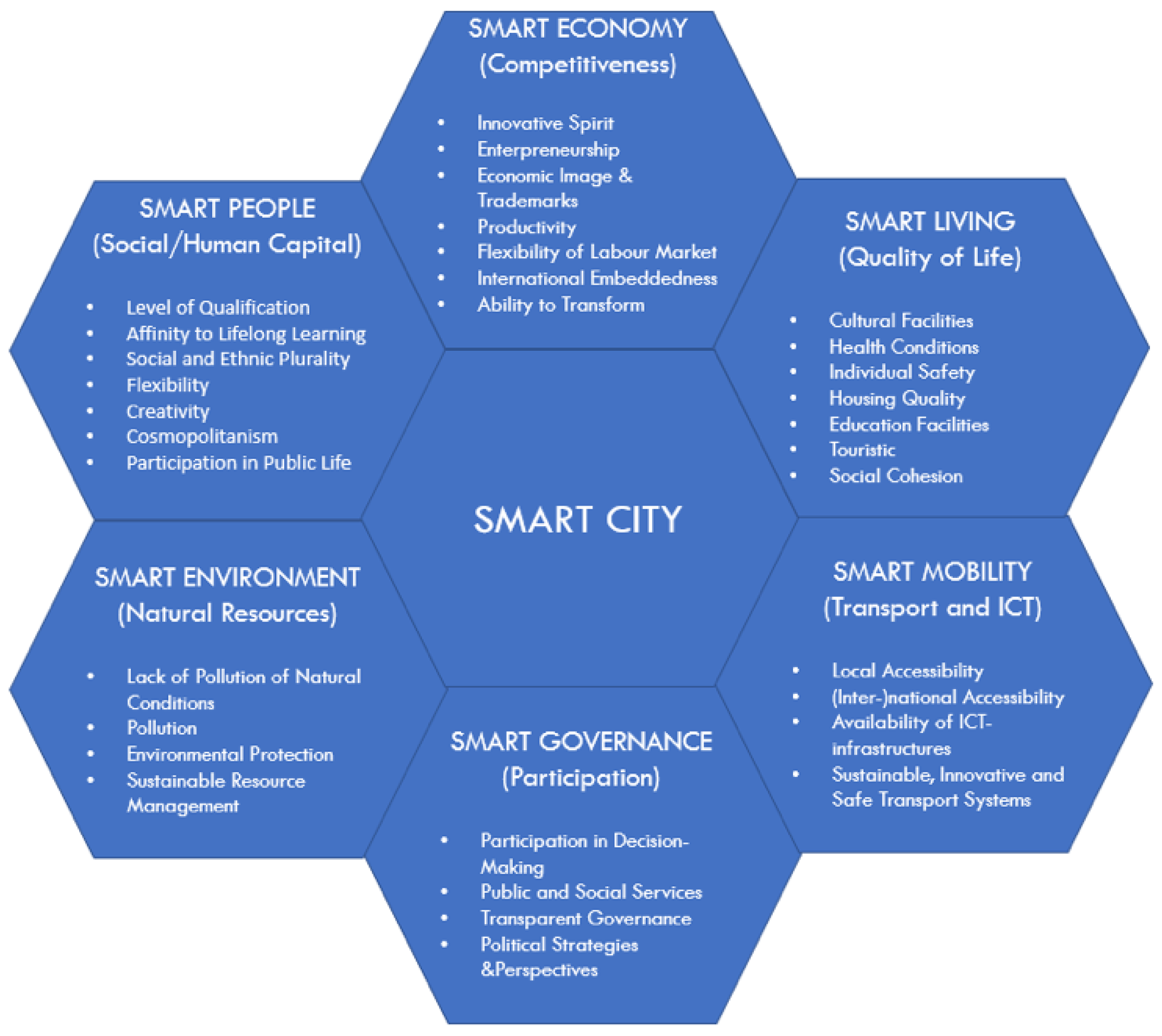
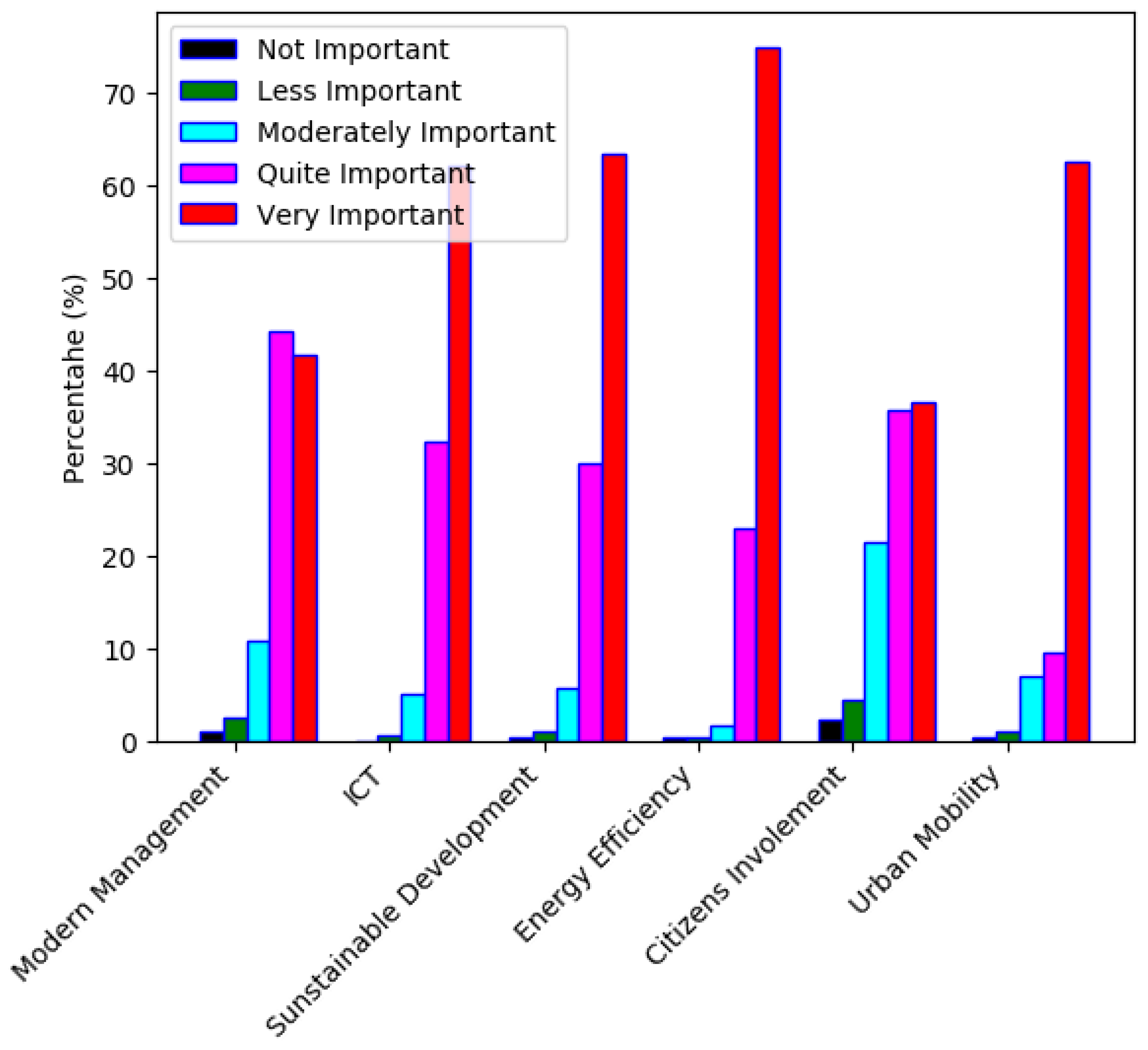

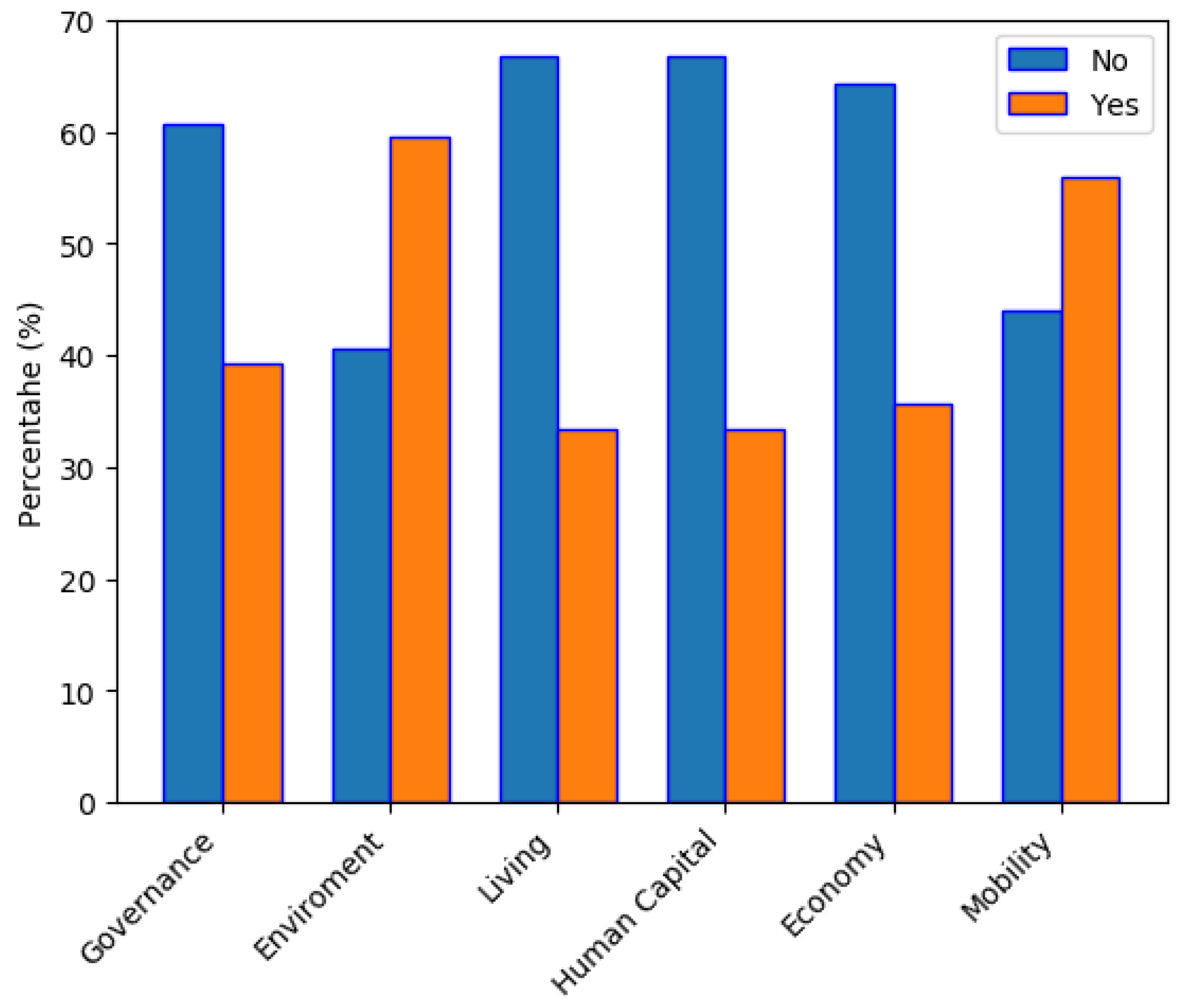
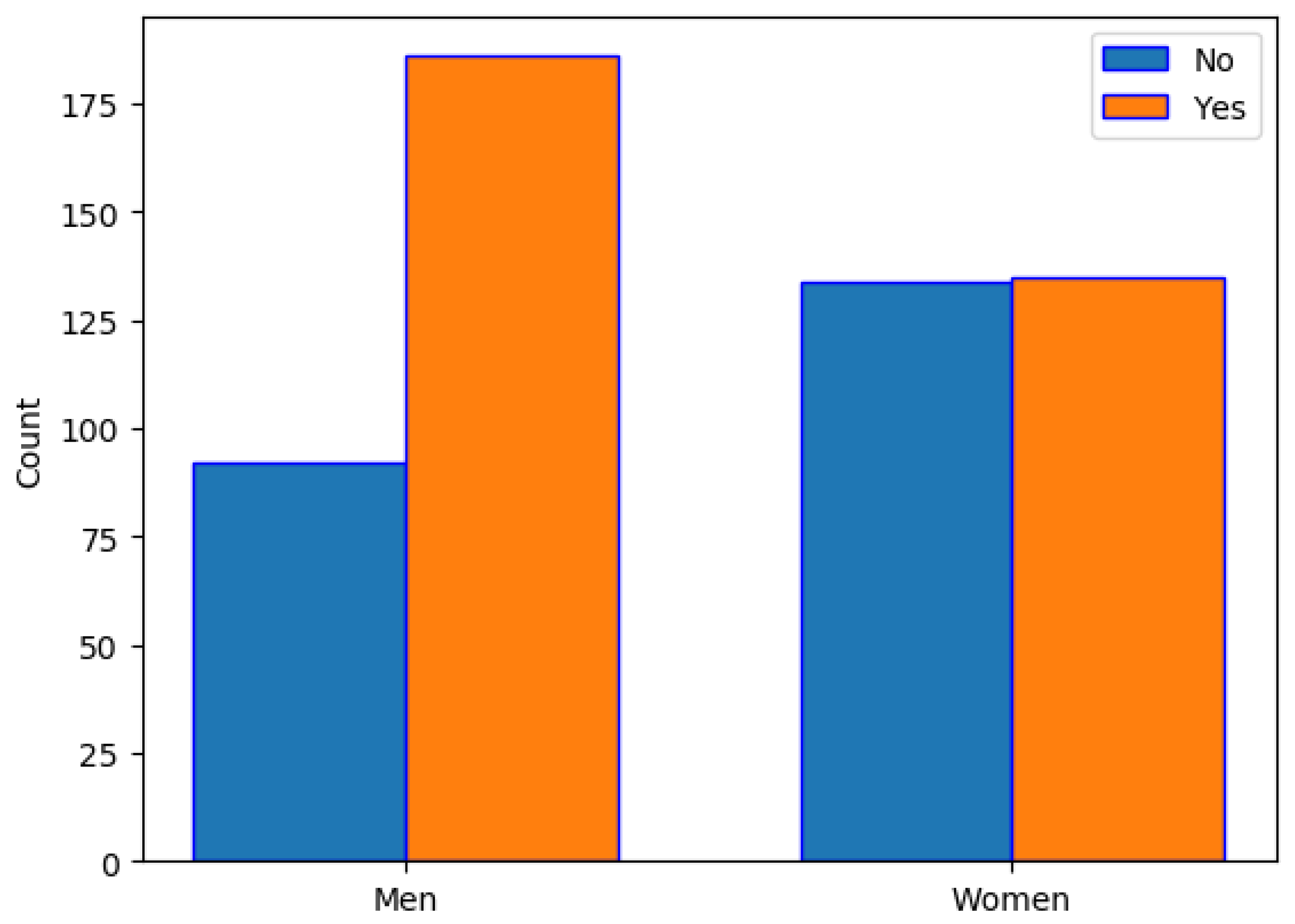
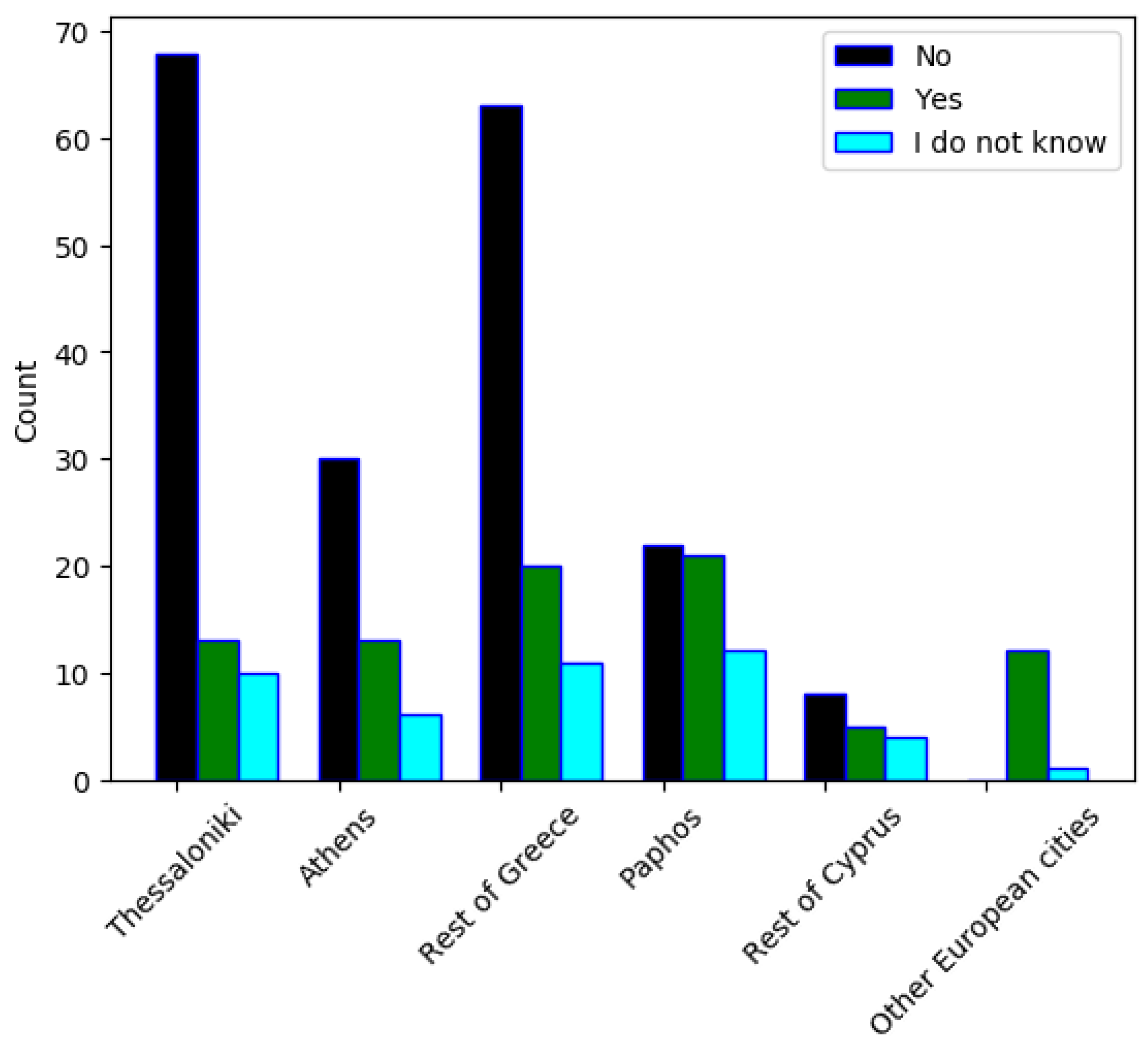

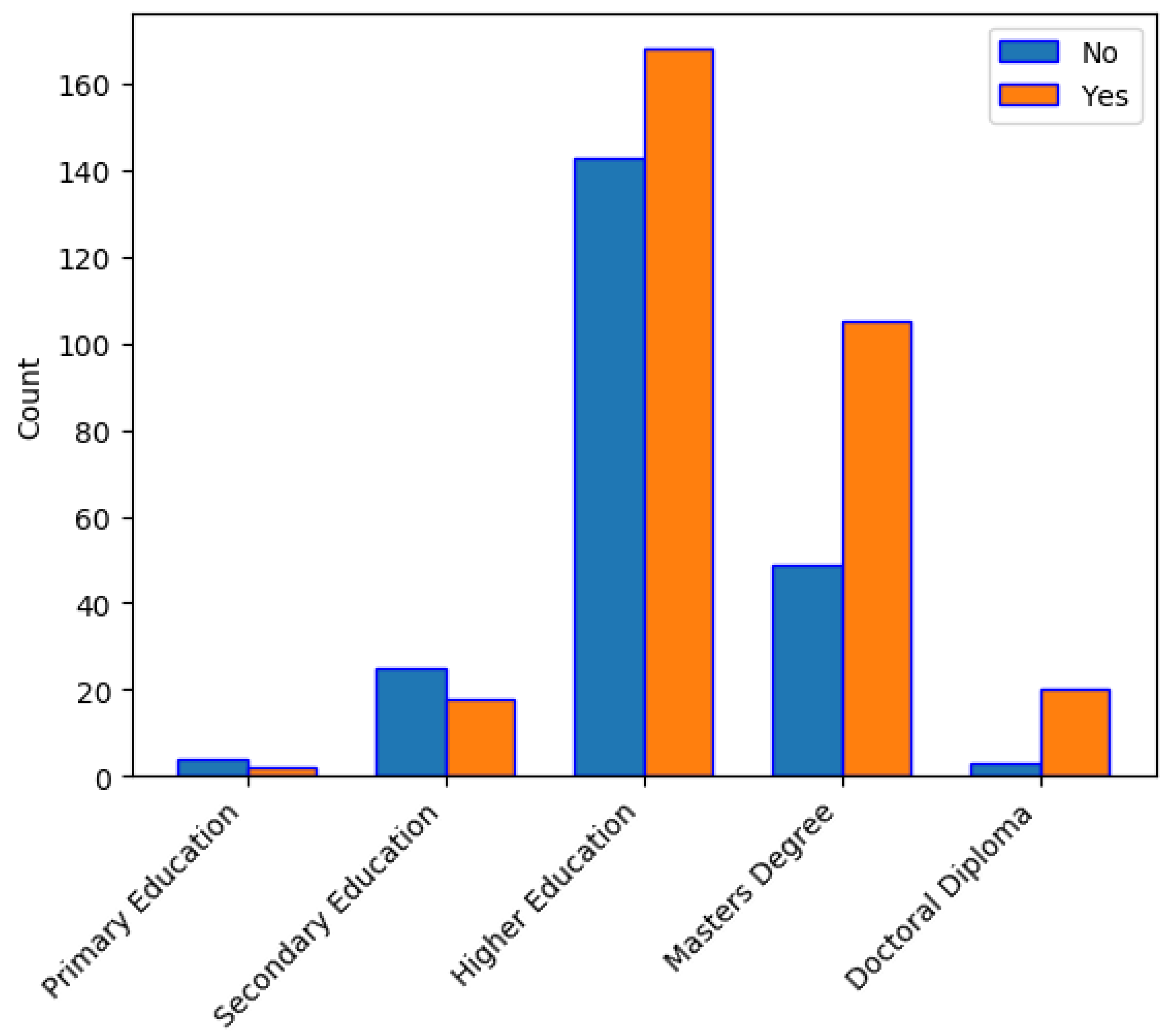
| Classification | Options | Values |
|---|---|---|
| Male | 278 (51%) | |
| Gender | Female | 267 (49%) |
| Sum | 545 | |
| 18–30 | 203 (37.2%) | |
| 31–40 | 274 (50.03%) | |
| Age | 41–50 | 51 (9.4%) |
| 51–60 | 13 (2.4%) | |
| Over 60 | 4 (0.7%) | |
| Primary Education | 6 (1.1%) | |
| Secondary Education | 43 (7.9%) | |
| Education | Higher Education | 311 (57.1%) |
| Master’s Degree | 154 (28.3%) | |
| Doctoral Diploma | 23 (4.2%) | |
| Other | 8 (1.5%) | |
| Civil Employee | 82 (15%) | |
| Private Employee | 260 (47.7%) | |
| Self-Employed/Freelancer | 107 (19.6%) | |
| Occupation | College Student | 46 (8.4%) |
| Retired | 4 (0.6%) | |
| Unemployed | 37 (6.8%) | |
| Other | 9 (1.8%) | |
| Thessaloniki | 181 (33.2%) | |
| Athens | 73 (13.4%) | |
| Paphos | 79 (14.5%) | |
| City | Rest of Greece | 160 (29.5%) |
| Rest of Cyprus | 29 (5.3%) | |
| Other European Countries | 22 (4%) |
| Smart | Smart | Smart | Smart | Smart | Smart | |
|---|---|---|---|---|---|---|
| Governance | Enviroment | Living | Mobility | People | Economy | |
| Not Important | 0.3% | 0.0% | 0.0% | 0.0% | 0.3% | 0.0% |
| Less Important | 4.1% | 0.3% | 0.3% | 0.9% | 2.2% | 0.9% |
| Moderately | 19.4% | 1.6% | 2.5% | 4.1% | 8.2% | 8.2% |
| Important | ||||||
| Quite Important | 41.7% | 26.3% | 19.4% | 25.4% | 34.8% | 37.3% |
| Very Important | 34.5% | 71.8% | 77.7% | 69.6% | 54.5% | 53.6% |
Publisher’s Note: MDPI stays neutral with regard to jurisdictional claims in published maps and institutional affiliations. |
© 2021 by the authors. Licensee MDPI, Basel, Switzerland. This article is an open access article distributed under the terms and conditions of the Creative Commons Attribution (CC BY) license (http://creativecommons.org/licenses/by/4.0/).
Share and Cite
Georgiadis, A.; Christodoulou, P.; Zinonos, Z. Citizens’ Perception of Smart Cities: A Case Study. Appl. Sci. 2021, 11, 2517. https://doi.org/10.3390/app11062517
Georgiadis A, Christodoulou P, Zinonos Z. Citizens’ Perception of Smart Cities: A Case Study. Applied Sciences. 2021; 11(6):2517. https://doi.org/10.3390/app11062517
Chicago/Turabian StyleGeorgiadis, Athanasios, Panayiotis Christodoulou, and Zinon Zinonos. 2021. "Citizens’ Perception of Smart Cities: A Case Study" Applied Sciences 11, no. 6: 2517. https://doi.org/10.3390/app11062517
APA StyleGeorgiadis, A., Christodoulou, P., & Zinonos, Z. (2021). Citizens’ Perception of Smart Cities: A Case Study. Applied Sciences, 11(6), 2517. https://doi.org/10.3390/app11062517








